Braised greens with lemon, olive oil, and garlic, known as horta, have been an integral part of the Greek diet since ancient times. Here’s how to transform an armload of greens into this nutritious side dish!
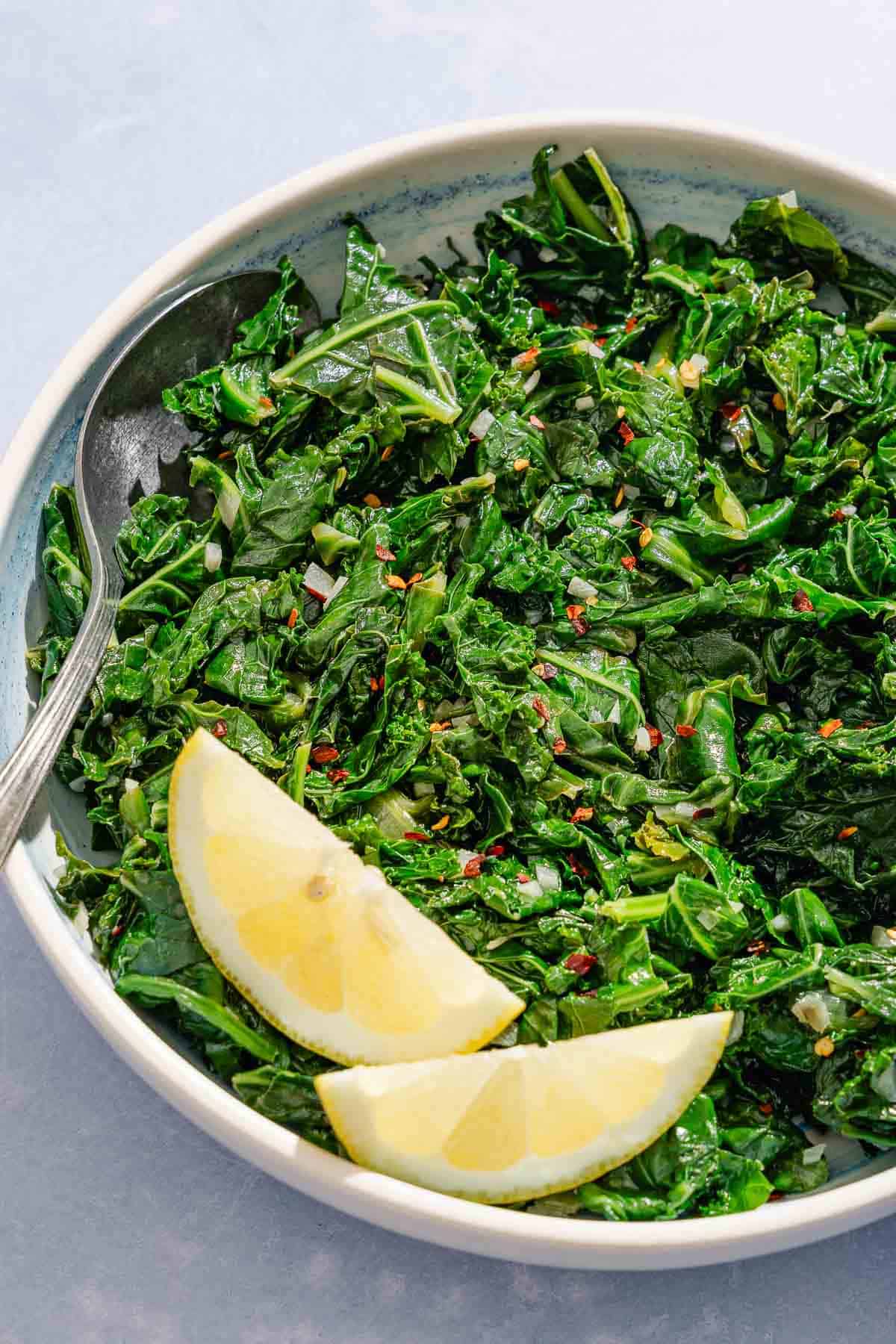
If you’ve ever traveled to Greece, you’ve probably come across a plate of horta—a simple, rustic dish of braised greens with a good drizzle of extra virgin olive oil and plenty of fresh lemon. It’s one of those everyday recipes that Greek families make without even thinking about it, and for good reason: it’s deeply nourishing, easy to prepare, and is incredibly flavorful despite its simplicity.
This dish comes together in about 30 minutes with just a few ingredients, but the payoff is huge. The greens cook down until tender and silky, bathed in flavor of garlicky olive oil and lemon, for a healthy, hearty, and comforting dish.
Table of Contents
What is Horta?
Horta is the Greek word for leafy green edible plants that grow wild throughout Greece and other parts of the Mediterranean. Praised for their exceptional nutritional value, fiber, and antioxidants, many Greeks attribute their good health to the large amounts of horta they consume every year!
The term horta can include many varieties of wild greens: wild fennel (marathos in Greek), amaranth (vlita in Greek), sorrel, dandelion greens, mustard greens, or ramp leaves. It can also include cultivated greens, including kale, Swiss chard, beet greens, and spinach.
Most of the foraged and cultivated greens fall into two general categories:
- Non-bitter greens: including spinach, Swiss chard, beet leaves, and wild fennel
- Bitter greens: mustard greens, dandelion greens, and amaranth.
Non-bitter greens are used in lots of traditional bean and grain soups, rice dishes, and hortopita, a type of spanakopita that calls for a variety of greens. Bitter greens are only served boiled or braised. Simmering them in liquid helps dilute and tone down the bitterness. Often, people combine both varieties of greens for this recipe. The more flavors and textures, the better!

What’s in Greek-style Braised Greens?
Braised greens in this style is a dish that reflects the simplicity of Greek cooking. The ingredient list is short, but each element is integral! Here’s everything you’ll need.
- Hearty mixed cooking greens: Use any mix of wild-harvested or cultivated, bitter or non-bitter cooking greens you like for this recipe. You can make this recipe using only one type of greens, however, I recommend using a variety as it adds interesting textures and flavors to the dish.
- Extra virgin olive oil: Use good quality olive oil to both sauté the greens and garlic and drizzle on the finished dish. I recommend the Private Reserve Extra Virgin Olive Oil from Greece for this recipe.
- Garlic: A few cloves of thinly sliced garlic add lots of flavor that complements the peppery and bitter flavors of the greens.
- Seasoning: Sea salt or kosher salt and freshly cracked black pepper are a must for this recipe. I also add a pinch of crushed red pepper flakes for some heat, but it’s optional.
- Lemon or red wine vinegar balances the earthy or bitter greens.
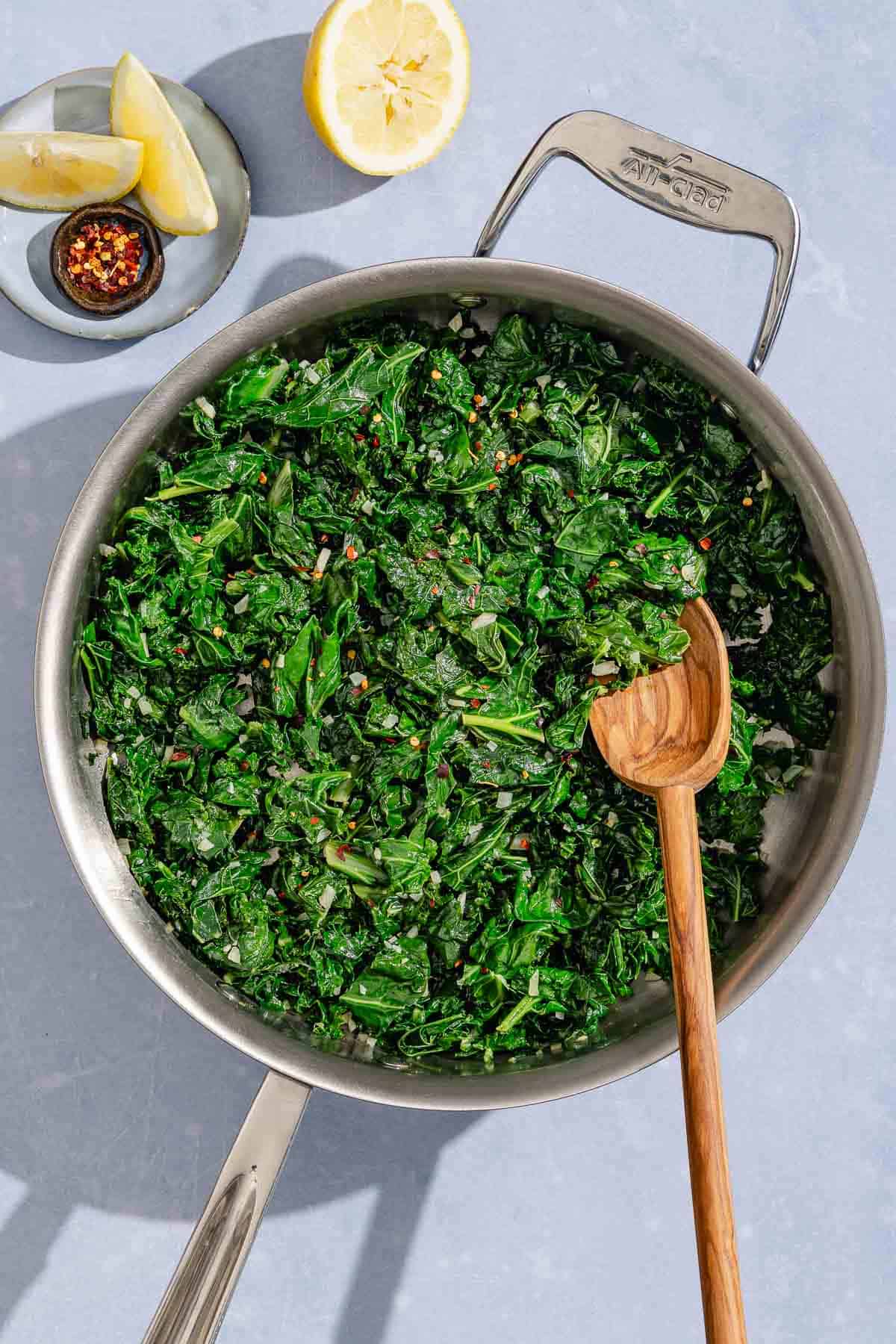
How to Make Braised Greens
Greek people often cook horta by simply boiling the greens in salted water until tender. I prefer to braise them, first quickly sautéing them, then adding just a little water before slowly simmering them. This yields tender greens glazed in lemony, garlicky liquid. Here’s the full process:
- Prep the greens. Thoroughly wash 1 pound of mixed cooking greens, like kale, Swiss chard or beet greens. Remove any tough stems. If the stems are tender, chop them into small pieces and then roughly chop the leaves.
- Sauté the garlic and greens. Place a large, deep skillet or a medium pot over medium-high heat. When it is hot, add 1/4 cup extra virgin olive oil. Stir in 4 medium-sliced garlic cloves and sauté for 30 seconds, until fragrant. Add half of the mixed greens and cook, stirring frequently, for 2 minutes. When the greens start to wilt, add the remaining greens to the skillet, stire and cook for 3 minutes more, just until all greens are wilted and evenly coated in olive oil.
- Braise the greens. Add 1/2 teaspoon sea salt or kosher salt, 1/4 teaspoon freshly ground black pepper, and 1 to 1 1/2 cups water. Stir. If you like some heat, add a pinch (or more) of red pepper flakes. Bring to a boil and reduce the heat to a simmer. Partially cover with a lid, to allow some steam to escape as the greens cook. Simmer the greens for about 10 minutes or so, until just tender. The cooking time will depend on the variety of greens. If, after 10 minutes, there is a lot of liquid left in the skillet, cook the greens for a few more minutes without a lid. You want the liquid reduced, but you don’t want the skillet dry.
- Season and serve. Turn off the heat and stir in 2 to 3 tablespoons lemon juice (from 1 to 2 fresh lemons). Taste and adjust the seasoning if needed. Serve slightly warm or at room temperature, drizzled with extra-virgin olive oil and lemon wedges.
How to Prep Cooking Greens
After washing the greens well, all it takes is some quick prep, and they’re ready to go into the pan. Here are some common supermarket greens you can use and how I recommend preparing them:
- Swiss Chard: Slice the stems thinly and then roughly chop the leaves.
- Beet greens: Save the beets to roast and treat the greens on top exactly as you would Swiss chard.
- Kale: Remove the tough stems and chop the leaves or cut them into ribbons.
- Spinach: Larger leaves of mature spinach, often sold in bunches, have more flavor than bagged baby spinach meant for salads. I don’t recommend baby spinach for this recipe as it’s too tender.
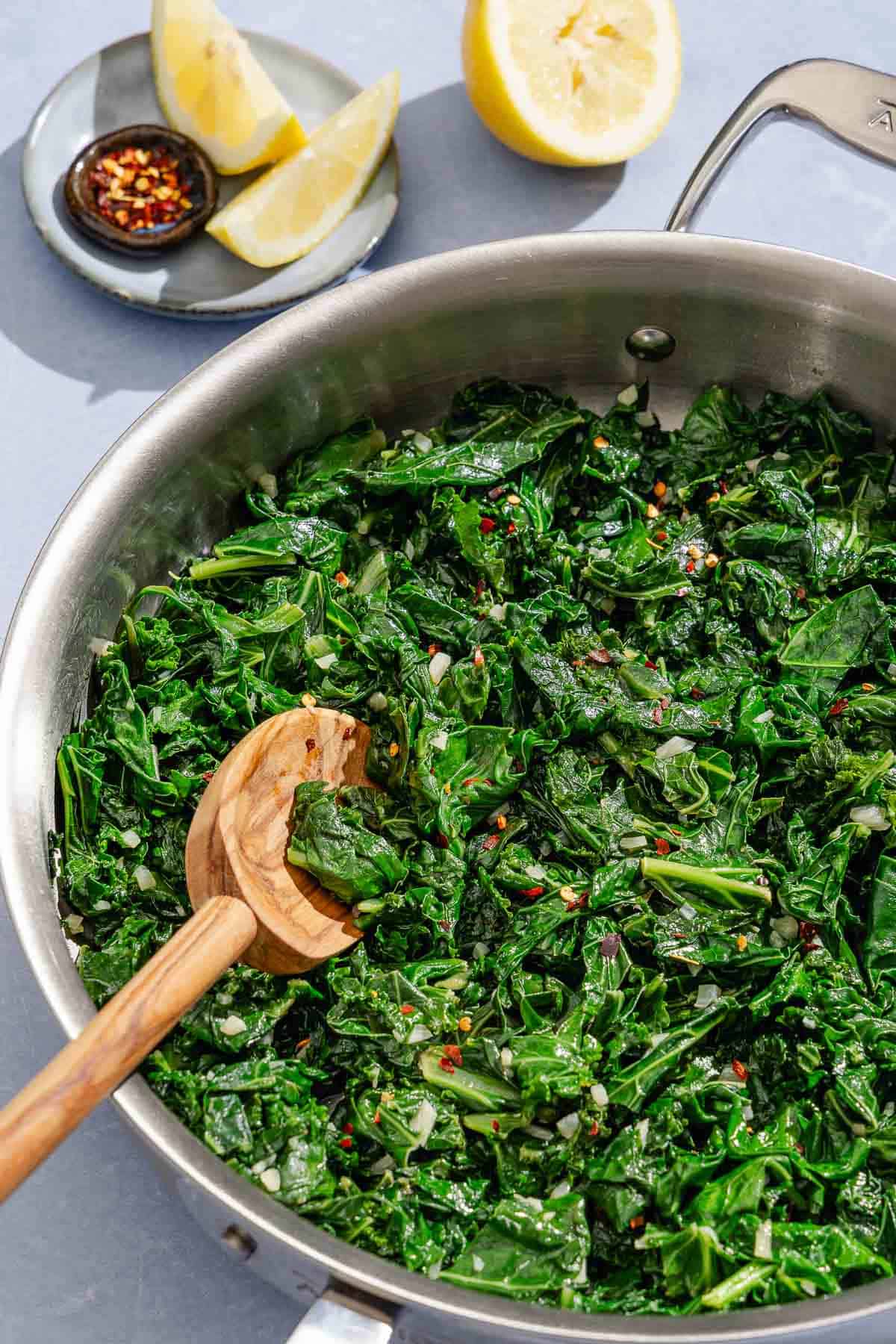
What to Serve with Braised Greens
This is a popular style dish at the Greek tavernas throughout the year, where these lemony greens are served alongside grilled seafood recipes,or simple marinated grilled chicken or lamb chops. I often make it with grilled trout or pan-seared shrimp. Enjoy this dish with plenty of hearty bread or lemon rice to mop up the delicious juices of the braised greens.
Not only are the greens high in nutritional value, but the liquid they cook in is high in vitamins and minerals too. Once the greens are removed from the pot, people in Greece do not waste any leftover cooking liquid. Once it cools down, they drink it, often with a squeeze of fresh lemon. Many swear by the health benefits!
More Great Greens Recipes
Browse all Mediterranean recipes.
Visit Our Shop.
Horta (Greek Braised Greens with Lemon and Garlic)
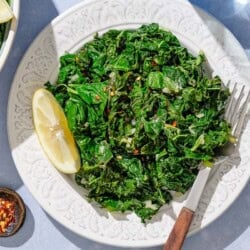
Ingredients
- 1 pound mixed cooking greens (kale, Swiss chard, beet greens), thoroughly washed
- 1/4 cup extra virgin olive oil
- 4 medium garlic cloves, sliced
- 1/2 teaspoon sea salt
- 1/4 teaspoon freshly ground black pepper
- 1 to 1 1/2 cups water
- Pinch red pepper flakes, optional
- 2 to 3 tablespoons fresh lemon juice, from 1-2 fresh lemons, plus lemon wedges for serving
Instructions
- Prep the greens. Remove any tough stems from the greens.If the stems are tender, chop them into small pieces and then roughly chop the leaves.
- Sauté the garlic and greens. Place a large, deep skillet or a medium pot over medium-high heat and when it is hot, add the olive oil. Stir in the sliced garlic and sauté for about 30 seconds, until fragrant. Add half of the mixed greens and cook, stirring frequently, for 2 minutes. When the greens start to wilt, stir in the remaining greens to the skillet and cook for 3 minutes more, just until all greens are somewhat wilted and evenly coated in olive oil.
- Braise the greens. Stir in the salt and pepper, then add 1 to 1 1/2 cups water; use more for heartier greens. If you like some heat, add a pinch (or more) of red pepper flakes. Bring to a boil and reduce the heat to a simmer. Partially cover with a lid, to allow some steam to escape as the greens cook. Simmer the greens for about 10 minutes or so, until just tender. The cooking time will depend on the variety of greens, you want there to be some liquid in the skillet but it shouldn't be soupy. If it is, soupy cook without the lid just until the liquid reduces, but the greens stay bright.
- Season and serve. Turn off the heat and stir in the lemon juice. Taste and adjust the seasoning if needed. Serve slightly warm or at room temperature with a drizzle of extra virgin olive oil and lemon wedges on the side.
- Season the cooking liquid: Do not waste any leftover cooking liquid! Once it cools down, add a squeeze of lemon and drink it.
Notes
- Shop this recipe: Visit our shop to browse quality Mediterranean ingredients including the olive oil used in this recipe.
- Choosing Greens: Use any mix of cooking greens you like for this recipe. You can make this recipe using only one type of greens, however, I recommend using a variety as it adds interesting textures and flavors to the dish.
-
-
- Swiss Chard: Slice the stems thinly and then roughly chop the leaves.
- Beet greens: Save the beets to roast and treat the greens exactly as you would Swiss chard.
- Kale: Remove the tough stems and chop the leaves or cut them into ribbons.
- Spinach: Larger leaves of mature spinach are often sold in bunches and have more flavor than bagged baby spinach meant for salads. I don’t recommend baby spinach for this recipe as it’s too tender.
-
Nutrition
Bundle and Save!
Four of our best-selling signature olive oils, perfect for everyday use.





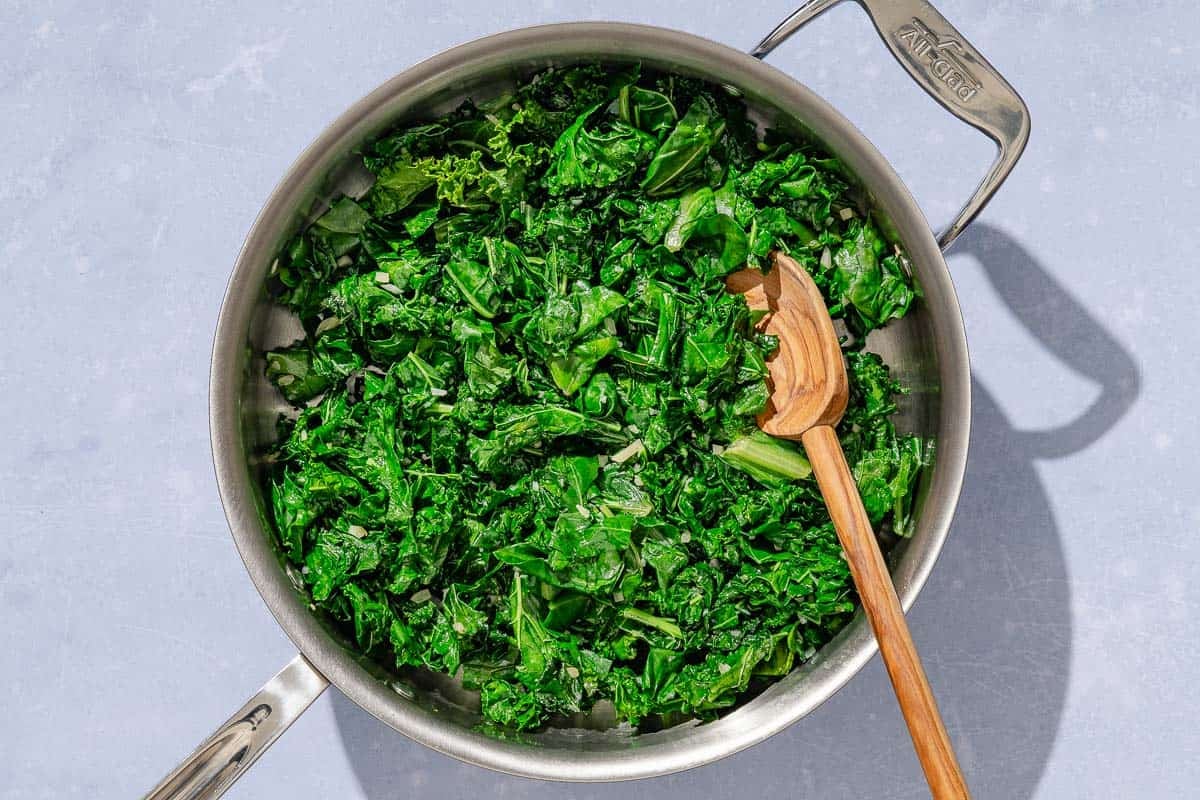
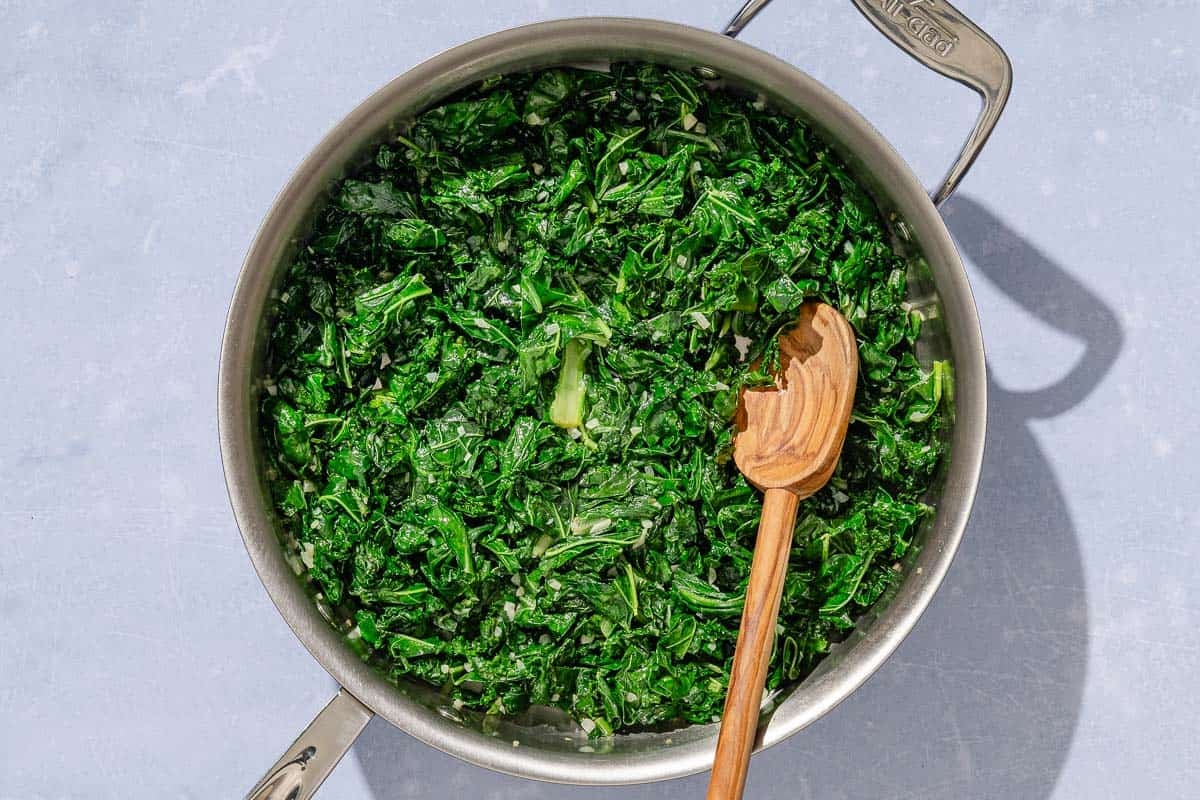


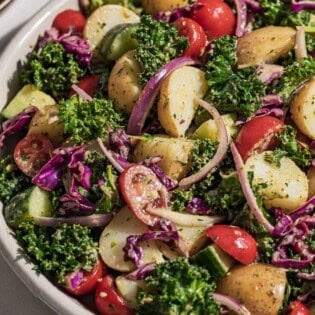
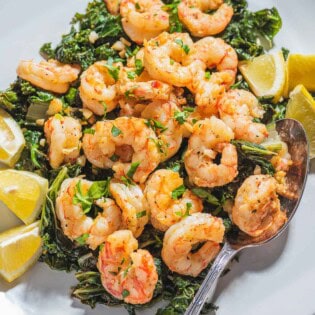
This is a wonderful recipe. I just adore the way this tastes. I gave it a star in my recipe and many of my favourite recipes don’t get a star. I was very surprised by just how good this is. The first time I made this, I made half the full recipe. I live alone, so I usually have to cut down recipes. Well, I made the full amount a couple of days ago. I had one serving and saved the rest. Last night I had two servings with supper and then I had to go finish off the rest of it as a snack. I was just craving more of this wonderful dish.
Is it freezable? I imagine it is since, it’s already very soft, so the texture shouldn’t be adversely affected. It would be very handy to have single servings in the freezer that could easily be nuked when I get a horta craving.
Looks awesome, yet your images look like they have finely diced red onion in them? Is that just missing from the recipe?
Hi, Julia! That’s actually the garlic that you’re seeing.
I love greens & do a wilt by salt massage. It is amazing how long fresh greens last in fridge prepared this way….BUT re your beautiful looking dish prep…it seems that you cook the greens quite a lot if I’m understanding it correctly. You saute them with the spices which I thought was the whole process, but then you braise as well or is that a choice between 2 ways to cook?
Hi, Christine. For this recipe you want to do both. First, sauté the greens and then braise them, as well.
I was skeptical of the long cooking time too. But, it is really, really good cooked this way.